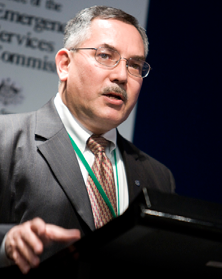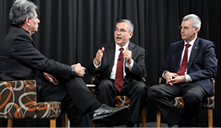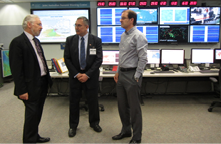
Reported by Alastair Wilson FEMPA
Through more than 50 presentations, workshops, public meetings and forums, visiting US Fulbright Senior Specialist Robert (Bob) Jensen has encouraged and inspired hundreds of Australians, endorsing the need to make public communications the core practice of emergency management.
Speaking to senior government officials, emergency sector corporate affairs and information professionals as well as research students and private industry representatives, Bob Jensen has promoted the role of the disaster communicator as equal to, if not more important, than emergency response.
Mr Jensen, who is the Principal Deputy Assistant Secretary for Public Affairs with the US Department of Homeland Security, took his proactive messages across the country during May, including to such events as the recent disaster recovery forum and a private industry workshop hosted by the Australian Emergency Management Institute, These events were attended by 61 and 72 delegates respectively. There were public meetings in universities, briefings for senior defence, police and emergency services officers in several cities, private briefings with federal department secretaries, US Consuls-General and the US Ambassador Jeffrey Bleich. He concluded his tour by giving the keynote address to the 7th annual Emergency Media and Public Affairs (EMPA) Conference in Brisbane early in June.
Hosted here by the Australian National University and the University of Southern Queensland, Mr Jensen’s national Fulbright tour has been facilitated by the EMPA not-for-profit group. He is an International Fellow of EMPA, which is the only such association of emergency media and public information professionals in the world.
A graduate of the American Air War College Bob Jensen has served his country for over 30 years. In recent times, in addition to serving two years in Iraq as senior communications adviser to the spokesman for the multi-national force and acting spokesman at the US embassy in Baghdad, he led a team to survey US strategic communication efforts in Afghanistan. He then set up and led the information centre after the massive Haiti earthquake in January 2010. Three months after that disaster he was deployed to set up the US Coastguard communications efforts for the response to the Deepwater Horizon Gulf oil spill.
Then came Hurricane Sandy that tore up the east coast to threaten New Yorkers last year; during that emergency Bob headed public affairs for FEMA employing some 2500 additional communications people to doorknock vulnerable communities with advice about disaster preparedness and possible evacuation. “This is where I really learned about effective communications at the community level,” he said.

Perhaps the ultimate call for Bob Jensen came following that disastrous event when he was seconded as Assistant Press Secretary for Foreign Affairs and Director for Public Affairs and Communications for the National Security Council at the White House. He describes this task as “…an intense and demanding 24-seven role, always on alert to international and domestic events, but with the buzz that comes with working alongside the President of the United States”. After only one day off throughout the whole year he decided to move back to the Homeland Security Department to be Deputy Secretary for Public Affairs.
Bob said he was delighted to be invited as an Australian-American Fulbright Senior Specialist to undertake a five week tour here facilitated by the EMPA not-for-profit group. “This volunteer group of emergency communicators swung a team of more than a dozen into action to coordinate an incredible schedule of events and briefings across five states.”
Whilst admitting that he was learning as much as he was presenting in Australia, Mr Jensen’s primary message was that there is no definite type of community when it comes to disasters and emergency incidents – either weather-driven or human-caused. “The challenge and responsibility for communicators is to relate and connect to every variety of community, not forgetting the latest virtual communities,” he adds.
“Reaching the widest possible audience with the most up-to-date, credible information can save lives and property as well as reduce public fears and anxiety,” said Mr Jensen. He adds that another advantage is it will maintain the public’s trust in the integrity of government officials and their decision making. “So the role of emergency communication is as important, if not more so, than the actual response to the disaster.”

Bob Jensen is interviewed by ABC 666 local radio presenter, Alex Sloan.
Jensen emphasises that in the global emergency management sector Australia has a good image in the US. “Whilst the scale and density of population impacted is much greater, the major disaster types – hurricanes/cyclones, wildfires, floods – are very much the same. However a major difference is that in the US the federal emergency agency plays a much greater role in response and recovery,” he said. He adds that there are strong parallels with training, leadership and funding support – especially during recovery – and in building resilience in communities.

Dr John Harrison at the University of Queensland public meeting, with EMPA CEO Peter Rekers, interview Bob Jensen.

A visit to the Joint Earthquake and Tsunami Watch
Centre at Geoscience Australia in Canberra with
tsunami specialist Dr Andy Barnicoat and Centre Manager Dr Dan Jaksa.
“I like to think that there is much that we can share to continue our learning in many areas, with a special focus on the critical public information arena,” said Mr Jensen. With this in mind he’s pushing for the establishment of an international working group involving Australia and New Zealand as well as the UK and Canada to start with.
While in Australia Mr Jensen took the opportunity, on behalf of the US Homeland Security Department, to discuss with senior Australian officials how the two countries can increase interaction with the sharing of ideas and skills, under the umbrella of a Memorandum of Cooperation recently signed between his department secretary Janet Napolitano and the Australian Attorney-General’s Department.
“This visit has been a valuable exercise for both countries,” he said. “We must now progress the dialogue into stronger links that will benefit both the emergency sector and our communities.”
Alastair Wilson was co-founder and is now a Fellow and Director of the Emergency Media and Public Affairs not-for-profit group. He recently retired from the Attorney-General’s Department Strategic Communications Branch and is an occasional contributor to AJEM.